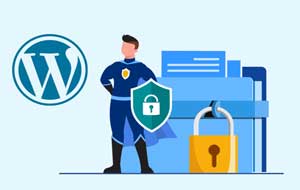How to secure WordPress
![]()
 WordPress is a very popular site. In fact, about 1 in 6 websites use it, making it a prime target for hackers.
WordPress is a very popular site. In fact, about 1 in 6 websites use it, making it a prime target for hackers.
Fortunately, hackers are generally lazy, and a few precautions can reduce the risk of being hacked to virtually zero.
Here are the precautions to take, sorted in order of priority:
6 essential precautions to keep your WordPress Blog safe from hackers.
Keep WordPress safe from Internet hackers!
1. Don’t use a password that’s too simple.
Most of us use the same passwords over and over again, and they’re often far too easy to figure out.
Hackers have a list of the most frequently used passwords on the Internet of several thousand words, and there’s even a list that exceeds a billion words!
Here are the first 24 to give you an idea of the power of this list:
|
|
|
Now add millions of other passwords and you can see just how powerful this list is, and how ineffective our conventional passwords are.
The best way, if not the only way, to counter this list is to create a long, complex password that is different every time.
But creating a long, complex password for every form you fill in on the Web quickly becomes unmanageable, and it’s impossible to remember them all.
The solution to this problem is called “RoboForm” a clever little piece of software that integrates with your browser by default.
It will generate complex passwords on demand and fill in your online forms for you with a simple click of the mouse.
Roboform will then save all your sensitive data encrypted and securely on your computer.
It’s a practical, discreet and easy-to-use tool that will quickly become an indispensable part of your everyday online life.
Click here to download RoboForm!
2. Don’t use admin as your username.
In most automatic WordPress installations, the admin username is used by default, so changing the admin username to the one of your choice will already significantly reduce the risk of hacking.
But WordPress doesn’t allow you to change your username, so you’ll first need to create another username with the “Administrator” role, log out of your admin session, log back in with your new username and delete the admin user.
3. Do not display your username for your posts.
By default, most WordPress themes display the username for each new post, making it easy for the hacker to retrieve it with the appropriate script, so procedure N°2 above will have been useless.
To change the display name for your new posts, simply add a first name to your new user account and choose this first name from the “Name to be displayed publicly” drop-down menu, then save the changes.
This way, each time you make a new post, only the first name you’ve chosen will be displayed, and your user name remains hidden and secure.
4. Limit login attempts.
A plugin called “Limit Login Attempts” will help you limit login attempts.
It’s a small WordPress plugin that lets you block IP addresses that generate too many connection errors.
It’s very intuitive and easy to use, and works very well by default, so there’s no need to configure it for effective protection against excessive connection attempts.
5. Keep WordPress up to date.
WordPress updates regularly and these are notified on the WordPress dashboard.
They are mainly used to counter the vulnerabilities that hackers exploit to hack our blogs.
So make sure you update regularly!
6. Make regular backups.
Make regular backups of your WordPress blog, because despite all precautions, accidents can happen, and there’s nothing worse for a blogger than losing data.
To make your life easier, there are a multitude of plugins that will automatically make backups for you. All you have to do is schedule your backups according to the frequency with which you update your blog.
Once you’ve carried out these 6 safeguards, you’ll be able to sleep soundly without fearing for your WordPress blog. You’ll be safe from the majority of hacker attacks, which will divert your blog to another worpress blog that’s easier to hack.
You may also be interested in the following articles:
How to protect yourself from scams :

This article will show you the essential points to follow in order to avoid most of the various online frauds and scams!
See the article “How to protect yourself from scams”.
In this article, you’ll discover the most important criteria to take into account when choosing an antivirus!
See the article “Which Antivirus to Choose”.



